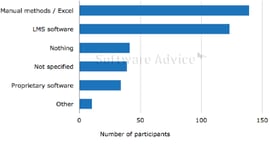What Is a LMS and How Is It Used?

You’ve heard people say it – ellemess – and you’ve nodded sagely when really, deep down, you’re wondering to yourself, ‘What is a LMS and how is it used?’
Or maybe you’ve got a fair idea of what it is, but you still think, ‘Why use a LMS?’
These are fair questions to ask – and we’re not blaming you for asking them. The world of tech can sometimes appear to be purposely obtuse, with murky wording designed to bamboozle solely you, while everyone else ‘gets it’. Let’s boil it down to its essence, then:
We’re talking about a system that reduces the admin of learning and training departments whilst also supporting an effective learning strategy, so it’s important to think about what it is, how it works, and whether it’s right for you and your company.
So, What is a LMS?
Simply put, LMS stands for learning management system – it’s an automated software application that aids organisations in delivering outstanding online lessons as well as classroom training courses for students and employees alike. It’s able to handle all aspects of learning and training, whether it’s delivering content, simplifying the booking process or excising time-consuming data input.
To confuse matters even more, LMS comes in a range of guises including training management system and course registration software.
Straight off, using a LMS beats the manual intensity of spreadsheets, or storing masses of data in Word and PDFs. For one thing, you can’t customise a universal program to perfectly fit your company, and for another, there’s always-always-always going to be data duplication when dealing with that many different programs (it’s the digital equivalent of writing a phone number down on a post-it note every time someone calls). And that almost always ends with the frustration of not being able to stay on top of everything.
In a nutshell, then, a LMS is all about making life easier for you and your employees, while providing an excellent resource for those who use the service. Win-win.
Why Use a LMS?
How do you currently book your users onto courses? Probably using an Excel spreadsheet or similar (or, if you’re truly old-school, manual records written on paper). A learning management system takes care of that process for you, and so much more, ensuring you can manage learning and development without any fuss. There are tons of reasons to get your hands on one, not least because they help reduce the amount of time spent on frankly mind-numbing administrative tasks (more about that, here). That leaves you with time to focus on what really matters: Running your business.
You can store all relevant data for your learners; you know, the stuff you’ll frequently need like contact details, the courses they’re booked on, that sort of thing. But you can also track communication with them – which beats sifting through a clogged up inbox for that one email they sent you months ago.
It’s high noon somewhere in the world, right? And just because you’re snoozing, doesn’t mean your learners are. Learning management systems offer 24/7 access for students, so if they want to complete their learning or research any other resources you may offer, they can. Not only does it make courses user-friendly, no matter where in the world you live, it also makes your business look awesome, expand globally and boosts your brand’s reputation (cue high-fives in the office)!

Speaking of global users, you’re a business, you’ve got your eye on the bottom line, and if we offered you a thousand dollars, you probably wouldn’t turn it down just because you use pound sterling. But when one of your students wants to pay for a course in a different currency, it can cause a serious headache (and that’s if you even accept anything other than your local currency). On the other hand, a LMS handles multiple currencies in the same way Usain Bolt handles a quick jog around the park: with absolute ease.
And then there’s the admin automation factor – which we’ve already touched upon already because, chances are, you were at work looking at where your employees’ time was spent, and realised a lot of their workload was dedicated to admin tasks. Registering learners, generating certificates, invoicing them, making strawberry cheesecake – ok, not that last one – all of that takes precious time (which, in business, equals money).
If we had to sum up learning management systems in one word, we’d go for… efficiency.
If we were going to add a few more words, we’d go for consistency, reliability and productivity.
LMS Features and Benefits
So what can we take-away from the LMS run-down? What are those all important features and key benefits for your company that will raise your learning management game?
- Automation of training admin, removing manual processes
- Online course booking
- Learner and employee access to their own portal
- Increased company efficiency, and reduction of admin time
- Flexibility means it can be scaled to your department’s needs
- 24/7 facility
- Manage and track employee training and compliance
- User tracking – so you can offer all-star service
- No more duplicated data and details
- Oversee the learner’s journey, from concept to completion
- Easy upload and access of course materials
- Total security-compliant system
So now you know what a LMS is, and how it’s used to increase the efficiency and produce the best results for you, your employees and your learners. Every day’s a school day, right?
And, if you have any more questions about learning management systems and how they can be used to support your business, book a live demo.
Discover how not to buy a LMS you can't stand right here.



